『真香警告』这33个超级好用的CSS选择器,你可能见都没见过。
- 作者:陈大鱼头
- github: KRISACHAN (opens new window)
# 前言
CSS 选择器是 CSS 世界中非常重要的一环。
在 CSS 2 之后,所有的 CSS 属性都是按模块去维护的。
CSS 选择器也是如此,然而如今也已经发布了第四版 —— CSS Selectors Level 4 ,这一版最早的草案发布于2011年09月29日,最后更新是2018年11月21日。
下面让我们一起来看看 Level 4 新推出的一些选择器。
# 正文
下面我们按照类型来划分
# 逻辑组合(Logical Combinations)
在这个分类下,我们有以下四个选择器:
# :not()
其实 :not() 不算是新标签,不过在 Level 4 里,增加了多选的功能,代码如下:
/* 除了.left, .right, .top之外所以的div的盒子模型都会变成flex
*/
div:not(.left, .right, .top) {
display: flex;
}
/* 等价于 */
div:not(.left), div:not(.right), div:not(.top) {
display: flex;
}
2
3
4
5
6
7
8
9
10
兼容性如下:
.png)
额。。。还不能用
# :is()
:is() 伪类将选择器列表作为参数,并选择该列表中任意一个选择器可以选择的元素。这对于以更紧凑的形式编写大型选择器非常有用。
看个栗子:
/* 选择header, main, footer里的任意一个悬浮状态的段落(p标签) */
:is(header, main, footer) p:hover {
color: red;
cursor: pointer;
}
/* 等价于 */
header p:hover,
main p:hover,
footer p:hover {
color: red;
cursor: pointer;
}
2
3
4
5
6
7
8
9
10
11
12
13
兼容如下:
.png)
# :where()
:where() 伪类接受选择器列表作为它的参数,将会选择所有能被该选择器列表中任何一条规则选中的元素。
其实就是跟 :is() ,唯一不同的就是 :where() 的优先级总是为 0 ,但是 :is() 的优先级是由它的选择器列表中优先级最高的选择器决定的。
代码如下:
<style>
:is(section.is-styling, aside.is-styling, footer.is-styling) a {
color: red;
}
:where(section.where-styling, aside.where-styling, footer.where-styling) a {
color: orange;
}
footer a {
color: blue;
}
</style>
<article>
<h2>:is()-styled links</h2>
<section class="is-styling">
<p>Here is my main content. This <a href="https://mozilla.org">contains a link</a>.
</section>
<aside class="is-styling">
<p>Here is my aside content. This <a href="https://developer.mozilla.org">also contains a link</a>.
</aside>
<footer class="is-styling">
<p>This is my footer, also containing <a href="https://github.com/mdn">a link</a>.
</footer>
</article>
<article>
<h2>:where()-styled links</h2>
<section class="where-styling">
<p>Here is my main content. This <a href="https://mozilla.org">contains a link</a>.
</section>
<aside class="where-styling">
<p>Here is my aside content. This <a href="https://developer.mozilla.org">also contains a link</a>.
</aside>
<footer class="where-styling">
<p>This is my footer, also containing <a href="https://github.com/mdn">a link</a>.
</footer>
</article>
2
3
4
5
6
7
8
9
10
11
12
13
14
15
16
17
18
19
20
21
22
23
24
25
26
27
28
29
30
31
32
33
34
35
36
37
38
39
40
41
42
:is() 跟 :where() 对比效果图如下:

兼容性如下:
.png)
# :has()
:has() 伪类代表一个元素,其给定的选择器参数(相对于该元素的 :scope)至少匹配一个元素。
:has() 接受一个选择器组作为参数。在当前规范中 :has() 并未列为实时选择器配置的一部分,意味着其不能用于样式表中。
语法如下:
// 下面的选择器只会匹配直接包含 <img> 子元素的 <a> 元素
a:has(> img)
// 下面的选择器只会匹配其后紧跟着 <p> 元素的 <h1> 元素:
h1:has(+ p)
2
3
4
5
兼容性如下:
.png)
嗯,全红。。。
# 语言伪类(Linguistic Pseudo-classes)
# :dir()
:dir()伪类匹配特定文字书写方向的元素。在HTML中, 文字方向由dir属性决定。其他的文档类型可能有其他定义文字方向的方法。
:dir() 并不等于使用 [dir=…] 属性选择器。后者匹配 dir 的值且不会匹配到未定义此属性的元素,即使该元素继承了父元素的属性;类似的, [dir=rtl] 或 [dir=ltr]不会匹配到dir属性的值为auto的元素。而 :dir()会匹配经过客户端计算后的属性, 不管是继承的dir值还是dir值为auto的。
例子如下:
<style>
:dir(ltr) {
background-color: yellow;
}
:dir(rtl) {
background-color: powderblue;
}
</style>
<div dir="rtl">
<span>test1</span>
<div dir="ltr">test2
<div dir="auto">עִבְרִית</div>
</div>
</div>
2
3
4
5
6
7
8
9
10
11
12
13
14
15
效果如下:
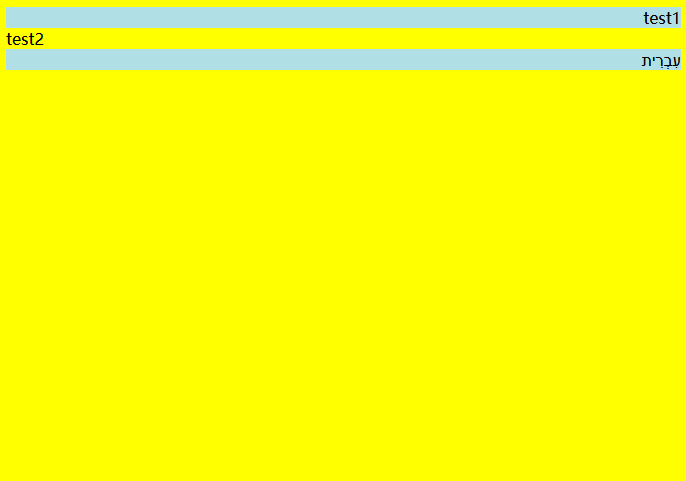
兼容性如下:
.png)
又是一片红。。
# :lang()
:lang() 伪类基于元素语言来匹配页面元素。
例子如下:
/* 下例表示选择文本语言带有-TN的div元素 (ar-TN, fr-TN). */
div:lang(*-TN) {
background-color: green
}
2
3
4
5
浏览器支持状态:没有一个支持的。
# 位置伪类(Location Pseudo-classes)
# :any-link
:any-link 伪类 选择器代表一个有链接锚点的元素,而不管它是否被访问过,也就是说,它会匹配每一个有 href 属性的 <a>、<area> 或 <link>元素。因此,它会匹配到所有的 :link 或 :visited。
例子如下:
<style>
a:any-link {
border: 1px solid blue;
color: orange;
}
/* WebKit 内核浏览器 */
a:-webkit-any-link {
border: 1px solid blue;
color: orange;
}
</style>
<a href="https://example.com">External link</a><br>
<a href="#">Internal target link</a><br>
<a>Placeholder link (won't get styled)</a>
2
3
4
5
6
7
8
9
10
11
12
13
14
15
效果如下:
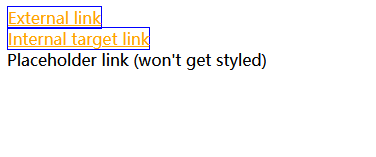
兼容性如下:
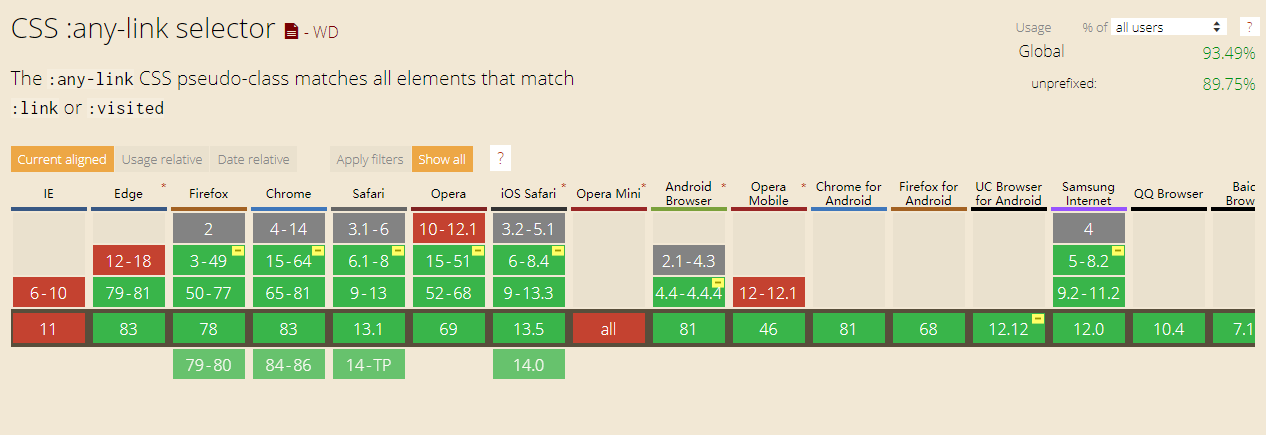
# :local-link
:local-link伪类可以单独格式化本地链接(原文是local links)(内部链接)。
例子如下:
a:local-link {
text-decoration: none;
}
2
3
效果 & 兼容性
没有一个浏览器是支持的,看不到效果
# :target-within
:target-within伪类适用于:target所匹配的元素,以及它DOM节点内所有匹配的元素。
例子如下:
div:target-within {
border: 2px solid black;
}
2
3
效果 & 兼容性
没有一个浏览器是支持的,看不到效果
# :scope
:scope伪类表示作为选择器要匹配的作用域的元素。不过目前它等效于 :root。
因为尚未有浏览器支持CSS的局部作用域。
例子如下:
:scope {
background-color: lime;
}
2
3
兼容性如下:

浏览器算法不支持,兼容有跟没没区别~
# 用户行为伪类(User Action Pseudo-classes)
# :focus-visible
当元素匹配 :focus 伪类并且客户端(UA)的启发式引擎决定焦点应当可见(在这种情况下很多浏览器默认显示“焦点框”。)时,:focus-visible 伪类将生效。
这个选择器可以有效地根据用户的输入方式(鼠标 vs 键盘)展示不同形式的焦点。
例子如下:
<style>
input, button {
margin: 10px;
}
.focus-only:focus {
outline: 2px solid black;
}
.focus-visible-only:focus-visible {
outline: 4px dashed darkorange;
}
</style>
<input value="Default styles"><br>
<button>Default styles</button><br>
<input class="focus-only" value=":focus only"><br>
<button class="focus-only">:focus only</button><br>
<input class="focus-visible-only" value=":focus-visible only"><br>
<button class="focus-visible-only">:focus-visible only</button>
2
3
4
5
6
7
8
9
10
11
12
13
14
15
16
17
18
19
效果如下:
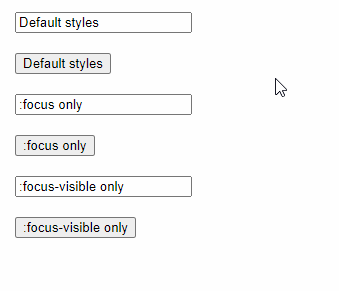
兼容性如下:
目前只有Chrome 67+ 兼容...
# :focus-within
:focus-within伪类适用于:focus所匹配的元素,以及它DOM节点内所有匹配的元素。
例子如下:
<style>
form {
border: 1px solid;
color: gray;
padding: 4px;
}
form:focus-within {
background: #ff8;
color: black;
}
input {
margin: 4px;
}
</style>
2
3
4
5
6
7
8
9
10
11
12
13
14
15
16
效果如下:
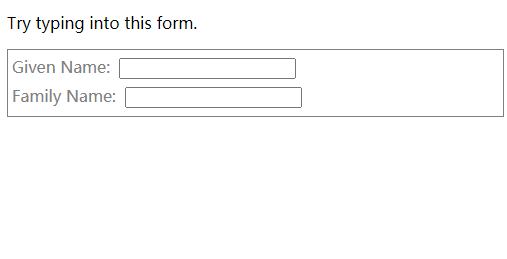
# 时间尺寸伪类(Time-dimensional Pseudo-classes)
# :current && :past && :future
这个伪类选择器会选择HTML5中<video>的语言渲染以及播放过程中的时间维度相对元素。所有相关的选择器都像:matches()。这几个伪类选择器的区别在于:past会选择:current所选的元素之前的所有节点。所以,:future就是指之后的所有节点了。
例子如下:
/* Current */
:current(p, span) {
background-color: yellow;
}
/* Past */
:past,
/* Future */
:future {
display: none;
}
2
3
4
5
6
7
8
9
10
11
12
兼容性如下:
目前没有任何浏览器支持
# 输入伪类(The Input Pseudo-classes)
# :read-only 与 :read-write
:read-only伪类选择器表示当前元素是用户不可修改的。
:read-write伪类选择器表示当前元素是用户可修改的。这个伪类选择器可以使用在一个可输入的元素或 contenteditable 元素(HTML5 属性)。
例子如下:
<style>
:read-only {
font-size: 20px;
color: green;
}
:read-write {
border: 1px solid orange;
font-size: 18px;
}
</style>
<input type="text" placeholder='text here'>
<input type="tel" placeholder='number here'>
<select>
<option>1</option>
<option>2</option>
</select>
2
3
4
5
6
7
8
9
10
11
12
13
14
15
16
17
18
效果如下:

兼容性如下:

# :placeholder-shown
:placeholder-shown 伪类 在 <input> 或 <textarea> 元素显示 placeholder text 时生效。
例子如下:
<style>
input {
border: 2px solid black;
padding: 3px;
}
input:placeholder-shown {
border-color: silver;
}
</style>
<input placeholder="Type something here!">
2
3
4
5
6
7
8
9
10
11
效果如下:

兼容性如下:
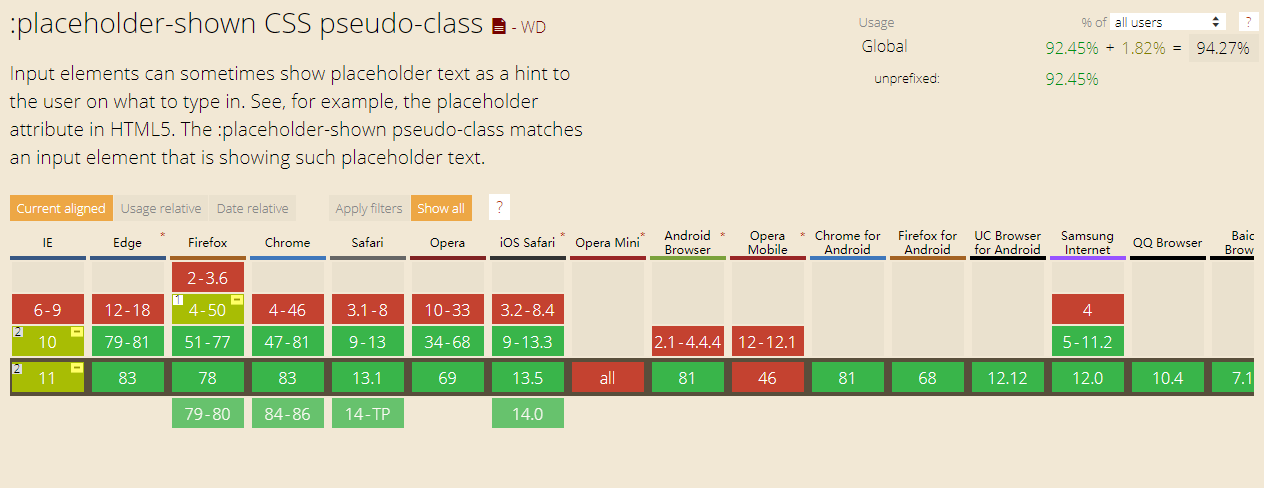
# :default
:default 伪类选择器 表示一组相关元素中的默认表单元素。
该选择器可以在 <button>, <input type="checkbox">, <input type="radio">, 以及 <option> 上使用。
例子如下:
<style>
input:default {
box-shadow: 0 0 2px 1px coral;
}
input:default + label {
color: coral;
}
</style>
<input type="radio" name="season" id="spring">
<label for="spring">Spring</label>
<input type="radio" name="season" id="summer" checked>
<label for="summer">Summer</label>
<input type="radio" name="season" id="fall">
<label for="fall">Fall</label>
<input type="radio" name="season" id="winter">
<label for="winter">Winter</label>
2
3
4
5
6
7
8
9
10
11
12
13
14
15
16
17
18
19
20
效果如下:

兼容性如下:

# :indeterminate
:indeterminate 伪类选择器表示状态不确定的表单元素。
它支持:
<input type="checkbox">元素,其indeterminate属性被JavaScript设置为true。<input type="radio">元素, 表单中拥有相同name值的所有单选按钮都未被选中时。- 处于不确定状态的
<progress>元素
例子如下:
<style>
input, span {
background: red;
}
:indeterminate, :indeterminate + label {
background: lime;
}
progress {
margin: 4px;
}
progress:indeterminate {
opacity: 0.5;
background-color: lightgray;
box-shadow: 0 0 2px 1px red;
}
</style>
<div>
<input type="checkbox" id="checkbox">
<label for="checkbox">Background should be green</label>
</div>
<br />
<div>
<input type="radio" id="radio">
<label for="radio">Background should be green</label>
</div>
<br />
<progress></progress>
<script>
'use strict'
const inputs = document.querySelectorAll('input')
inputs.forEach(input => {
input.indeterminate = true
})
</script>
2
3
4
5
6
7
8
9
10
11
12
13
14
15
16
17
18
19
20
21
22
23
24
25
26
27
28
29
30
31
32
33
34
35
效果如下:

兼容性如下:
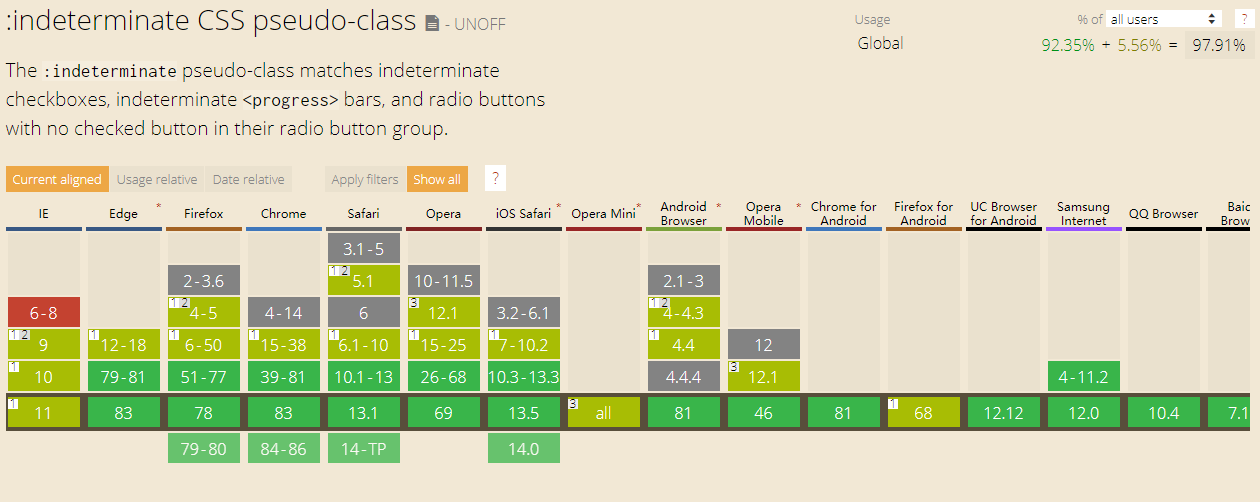
# :valid 与 :invalid
判断有效性的伪类选择器(:valid和:invalid)匹配有效或无效,<input>或<form>元素。
:valid伪类选择器表示值通过验证的<input>,这告诉用户他们的输入是有效的。
:invalid伪类选择器表示值不通过通过验证的<input>,这告诉用户他们的输入是无效的。
例子如下:
<style>
input:valid {
outline: 1px solid green;
}
input:invalid {
outline: 1px solid red;
}
</style>
输入文字:
<input type="text" pattern="[\w]+" required />
<br />
输入电话号码:
<input type="tel" pattern="[0-9]+" required />
2
3
4
5
6
7
8
9
10
11
12
13
14
效果如下:

兼容性如下:

# :in-range 与 :out-of-range
如果一个时间或数字<input>具有max或min属性,那么:in-range会匹配到输入值在指定范围内的<input>,:out-of-input则匹配输入值不在指定范围的<input>。如果没有规定范围,则都不匹配。
例子如下:
<style>
li {
list-style: none;
margin-bottom: 1em;
}
input {
border: 1px solid black;
}
input:in-range {
background-color: rgba(0, 255, 0, 0.25);
}
input:out-of-range {
background-color: rgba(255, 0, 0, 0.25);
border: 2px solid red;
}
input:in-range + label::after {
content: 'okay.';
}
input:out-of-range + label::after {
content: 'out of range!';
}
</style>
<form action="" id="form1">
<ul>Values between 1 and 10 are valid.
<li>
<input id="value1" name="value1" type="number" placeholder="1 to 10" min="1" max="10" value="12">
<label for="value1">Your value is </label>
</li>
</ul>
</form>
2
3
4
5
6
7
8
9
10
11
12
13
14
15
16
17
18
19
20
21
22
23
24
25
26
27
28
29
30
31
32
33
34
35
效果如下:
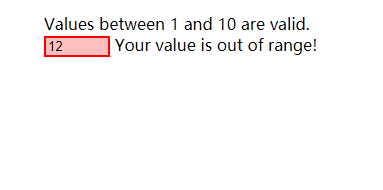
兼容性如下:
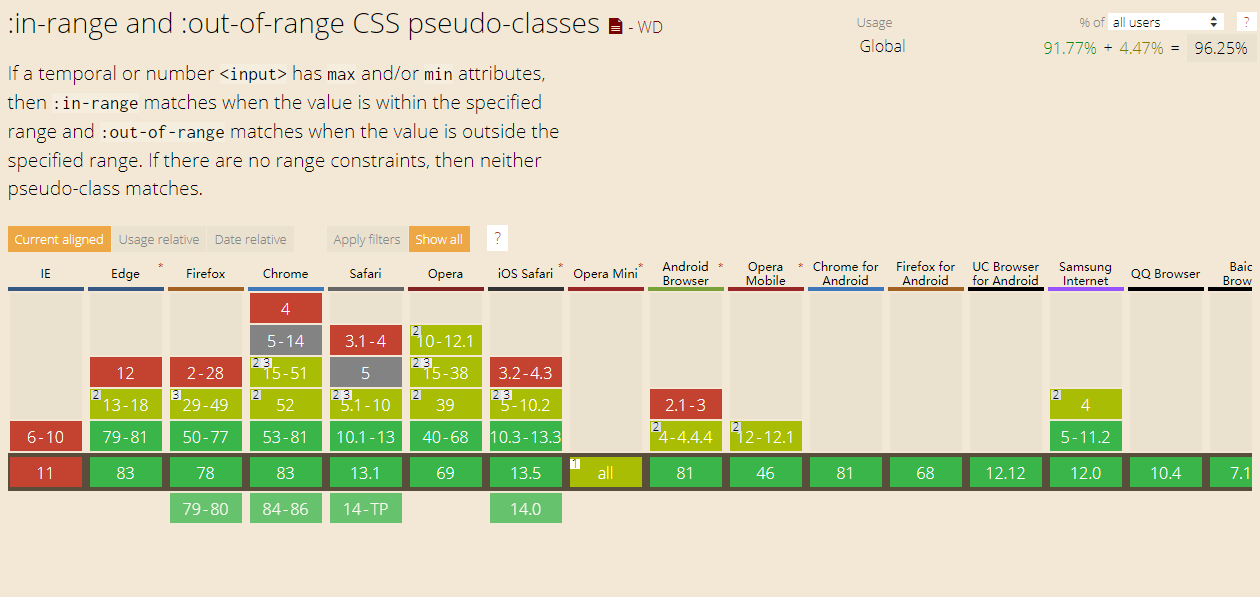
# :required 与 :optional
伪类选择器:required和:optional匹配了<input>,<select>, 或 <textarea>元素。
:required表示“必填”
:optional表示“可选”
例子如下:
<style>
input:required {
border: 1px solid orange;
}
input:optional {
border: 1px solid green;
}
</style>
必填的:<input type="text" required>
<br />
可选的:<input type="text">
2
3
4
5
6
7
8
9
10
11
效果如下:
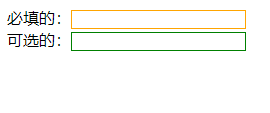
兼容性如下:

:required 的兼容性在上面有。
# :blank
:blank 伪类选择器 用于匹配如下节点:
- 没有子节点;
- 仅有空的文本节点;
- 仅有空白符的文本节点。
有点类似于:empty,但是比:empty宽松,目前还是没有任何一款浏览器支持。
# :user-invalid
:user-invalid伪类选择器匹配输入错误的元素。不过跟其它的输入伪类不同的是,它仅匹配用户输入时的错误,而不是静默状态下的错误,这样就会比较人性化,可惜,目前还是没有任何一款浏览器支持。
# 树型伪类(Tree-Structural pseudo-classes)
# :nth-child 与 :nth-last-child
:nth-child 与 :nth-last-child并不是 Level 4 才推出的伪类选择器,但是在 Level 4 里 新增了在元素组里匹配的功能。
语法如下::nth-child/nth-last-child(An + B [of S] ?)
例子如下:
:nth-child(-n+3 of li.important)
上面的例子通过传递选择器参数,选择与之匹配的第n个元素,这里表示li.important中前三个子元素。
它跟以下规则不同:
li.important:nth-child(-n+3)
这里表示的时候如意前三个子元素刚才是li.important时才能被选择得到。
兼容性如下:
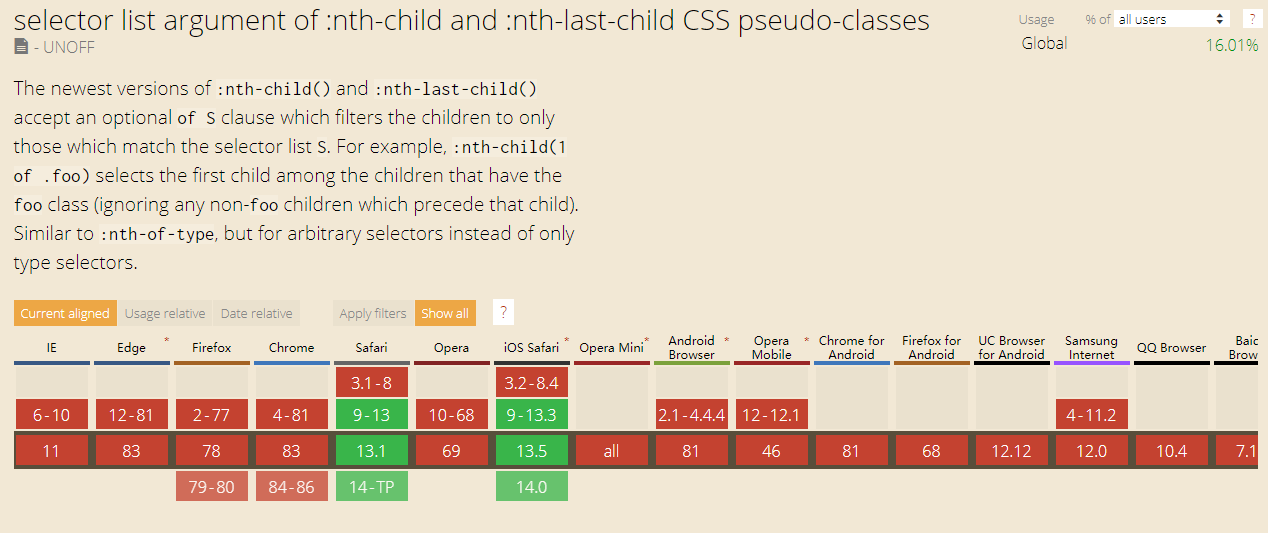
(鱼头注:牛皮,Safari居然弯道超车了,不过别的浏览器不支持,也没啥用...)
# 网格选择器(Grid-Structural Selectors)
# ||
|| 组合器选择属于某个表格行的节点。
例子如下:
<style>
col.selected || td {
background: gray;
color: white;
font-weight: bold;
}
</style>
<table border="1">
<colgroup>
<col span="2"/>
<col class="selected"/>
</colgroup>
<tbody>
<tr>
<td>A
<td>B
<td>C
</tr>
<tr>
<td colspan="2">D</td>
<td>E</td>
</tr>
<tr>
<td>F</td>
<td colspan="2">G</td>
</tr>
</tbody>
</table>
2
3
4
5
6
7
8
9
10
11
12
13
14
15
16
17
18
19
20
21
22
23
24
25
26
27
28
上面的例子可以使C,E 与 G单元格变灰。
很可惜,目前还是没有任何浏览器给予支持。
# :nth-col() 与 :nth-last-col()
伪类选择器:nth-col() 与 :nth-last-col()表示选择正向或反向的表格行的节点。
语法和:nth-child 与 :nth-last-child类似,只不过它是选择表格内的元素。
目前还是没有任何浏览器支持。
# 最后
# 总结
以上便是CSS选择器 Level 4 里新出的所有选择器,其实都是非常有用的,虽然有些选择器的浏览器支持度并不乐观的。
希望各大浏览器厂商可以赶快增加对它们的支持吧。
# 参考资料
- can i use (opens new window)
- MDN (opens new window)
- Selectors Level 4 W3C Working Draft (opens new window)
# 后记
如果你喜欢探讨技术,或者对本文有任何的意见或建议,非常欢迎加鱼头微信好友一起探讨,当然,鱼头也非常希望能跟你一起聊生活,聊爱好,谈天说地。 鱼头的微信号是:krisChans95 也可以扫码关注公众号,订阅更多精彩内容。 公众号窗口回复『 前端资料 』,即可获取约 200M 前端面试资料,不要错过。

